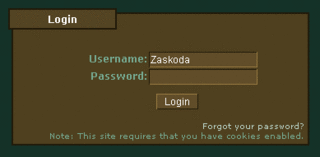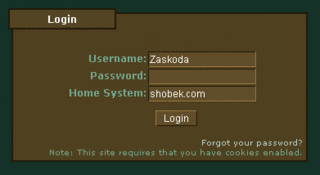Blog Blog Blogidy Blog
I suppose I’ve been a blogger longer than I realized. In August of 1996, I started making weekly web updates regarding the progress I was (or wasn’t) making on a computer RPG project. Back then, we just called them websites. Actually, to be more accurate, we called them Web sites as the Web was still something special enough to warrent a capitol letter.
I remember hearing the term blog for the first time around 2000. I actually read one particular personal blog regularly because I found the writing style to be completely compelling. As more and more blogs started to pop up around the Internet, I started to dislike the term. Part of me still felt that these blogs were just specifically formatted web pages and that giving them this trendy new name of ‘blog’ was pretentious.
Blogs Don’t Totally Suck, Only Mostly
I do have to give blogs some level of credit as their popularity has pushed web technologies along during a stagnant time. My favorite by-product is the powerful RSS format. Blogs have also encouraged the adoption of CSS techniques. In fact, at the beginning of last year (2004) I wanted to improve my xHTML/CSS knowledge and created an online journal about snowboarding as a testing ground. You’ll notice that no where on the site do I call it a blog. 😉
I’ve never been a big fan of blogosphere evangelist. Think about it, you don’t find forum users posting endless threads about how posting to forums is going to revolutionize the face of the Internet. The same holds true for countless other online communities. Oh, but that blogging community, they love to love themselves. A few days ago I read a blog post that was about a blog post about blogging. This was a breaking point for me. The day I found that post, I turned anti-blog.
Well, here I am, posting a blog post about being anti-blog. That makes me sound like a hypocrite. What I mean by “anti-blog” does not mean I dislike the blog format itself. For content that is appropriate, blogs are well refined and generally easy to deploy. Aside from just hating the arrogance of the blog culture, I’m particularly none-to-keen on the over-use of blogs. A lot of content that is published via the blog format is not best tailored for that delivery method. In fact, the intent of my own blog here does not fit a blogging format. (Yes, I am guilty!) Ultimately, this format has influenced my content development to be more blog-like and less like I had originally intended. Anyway, I’m going to provide two examples of content types that are often deployed as blogs but would be better delivered in another customized format.
Essay Archives
My original intent for this site was to deliver more essays and less personal ramblings. While a brief post about the latest happenings with Google or Winamp might appeal to my audience, these posts should not be given the same treatment as a post about virtual community – the intended core subject of this site. In fact, this very post deviates from the topic. Anyway, I had originally hoped that this site would be a collection of small essays with useful content about virtual communities. On Life With Alacrity, Christopher Allen has done a good job of keeping the majority of his posts on topic and in an essay style format. With this example in mind, we can consider how his content (and my intended content) could be delivered better.
First, let’s consider where the blog format is weak for essay delivery. A blog is generally organized by date and time. Occasionally a blog will also include a single layer of categories or groups. More than any other parameter, “recent’ content is given priority in a blog. This assumes that users visit your site regularly and keep up with your content. However, content like much of that found on Christopher’s site is timeless. As a first time visitor to his site, a user may be most interested in his oldest posts. The blogging format does not lend itself well to this scenario.
A better solution would be an essay archive format. This format would give more billing to the subject of content and less to the date it was posted. There would still exist a section of the site that would allow for denotations of recently added or updated content; but this would come secondary to a searchable index of multi-layered categorical organization. The format would likely look like a hybrid of software documentation and a directory. (note: I suspect this format exists, but failed to find a good example.)
E-Zine / Webzine
On the Gearbox website, we have a section called Gearblogs. Using a blog style format for this section ultimately created many brick walls. I forced the format to apply to content such as photo albums. While the format worked, I feel it was not a natural delivery. The blog format also created a “one content item per post” feeling. Given the nature of the content we have available for posting, I’ve often wanted to post a variety of pieces glumped together.
A webzine format (nothing new or revolutionary) would work very well. What surprises me is that this format never received a level of refinement comparable to blogs. Blogging is considerably more popular. Perhaps this is because the publication of an e-zine is best suited for a group of people; meanwhile, a single individual with something to say can get the message out quicker by posting a blog. Organizing the development of a full webzine would require extra work, and nobody likes to work anymore.
Back to the format: A webzine format would allow the bulk publication of multiple articles in an “issue” style delivery. This delivery would allow readers to enjoy a variety of information in regular intervals. This content could still be organized such that articles in older issues could easily be looked up via a search feature or a directory. Furthermore, since each issue will likely have the same basic structure (think of how the newspaper always has the same sections), readers can easily go back and catch up on any given section they are interested in.
A webzine could also still offer a constantly updated news section to track current events that would feel too dated if they were held until the next issue publication. In fact, if appropriate, a blog and forum could be rolled into the mix. In fact, this is much like how Sitepoint works. (Greets to all you sitepointers!)
I do plan to develop a webzine to replace Gearblogs in the near future. In retrospect, I think I might have been lured into the trendy nature of the blog format without fully considering how I really wanted to deliver content on our site. Or, perhaps, the blog format was a simple solution that got the job done when I needed to get a lot done quickly.
Conclusion
I haven’t presented any revolutionary ideas; however I still want to stress the need for both CMS developers and content producers to explore other standard delivery formats beyond the blog. I would very much like to see a powerful and easy to use webzine or essay archive service reach the same level of quality as blogger and typepad. Really, it’s time for bloggers to grow up.





